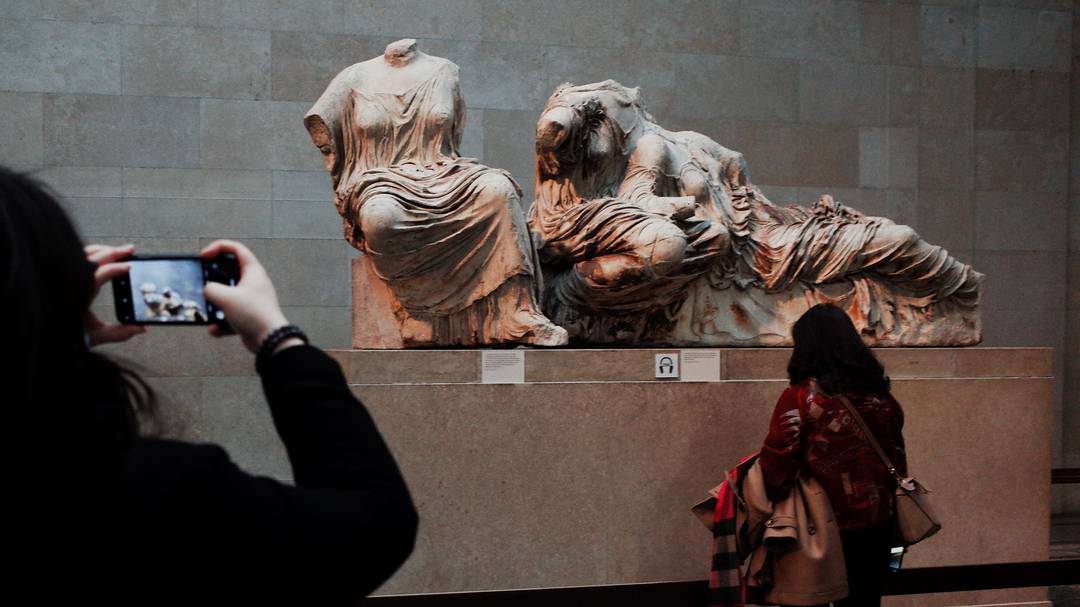Athens. Greek Prime Minister Kyriakos Mitsotakis did not have Lord Elgin’s marbles in his bags when he returned to Athens on Wednesday from a three-day visit to London. It would also be very heavy: the 220 tons of marble that the British diplomat Elgin stole from the Acropolis of Athens at the beginning of the 19th century and which the Greeks tried to surrender for 180 years. Even if the fronts in the conflict are tightened more than ever, Mitsotakis is not giving up. He returned from London with a clear message: “We want the sculptures back.”
It is more than 50 statues and fragments of gables and from the frieze of the Parthenon on the Acropolis, the most famous surviving structure from Greek antiquity. The artwork, including one of the figures of a girl from the Korenhalle des Erechtheion, is known as the “Elgin Marbles” in the British Museum in London. Between 1801 and 1810, Thomas Bruce Earl of Elgin, as British ambassador to Constantinople, broke the marbles from the Parthenon and shipped them to London. During his demolitions, in which he caused severe damage to the Parthenon, Elgin relied on permission from the Turkish occupiers, who ruled what is now Greece.
“An act of vandalism and barbarism”
For Melina Mercury, it was an “act of vandalism and barbarism.” During her 11 years as Greece’s Minister of Culture, the world-famous actress fought like no other politician in her country to bring back the marble shards. Thanks to their strong plea at UNESCO in Paris in 1982, the General Assembly of the United Nations cultural organization voted by a large majority in favor of returning the marbles.
The first request dates from 1842. At that time, Alexandros Ragavis, as secretary of the Athens Archaeological Society, applied for the return of the pieces. There was further Greek progress in 1934 and 1961. In a 1999 resolution, the European Parliament called on Great Britain to “examine the return of the marble shards in a positive spirit.”
So far, these endeavors and appeals have had no effect. The British Museum, to whom Elgin sold the collection for £35,000 in 1816, considers itself the rightful owner of the pieces. However, experts now doubt the validity of the mandate that allowed Elgin at the time to “remove any sculptures or reliefs” from the Acropolis. Many historians consider the seizure of the Parthenon fragments to be an art theft. British critics have spoken of “plunder” since the 19th century. Elgin himself reported to his foreign minister at that time: “In Athens I have now brought incredible treasures into my possession – nothing Bonaparte has stolen in all his forays into Italy!”
Boris Johnson considers himself incompetent
In the Acropolis Museum of Athens, which opened in 2009, the Greeks reserved a place for marble shards. It will be shown on the top floor, from where the Parthenon can be seen through its glass facade. The plaster casts of the sculptures have so far been displayed on a full-size replica of the frieze.
Mitsotakis said during his visit to the British capital that the marble shards are in London “because they were stolen.” Mitsotakis said he spoke to Boris Johnson about it. He is considered the British Prime Minister of the Phillellene. But his love for antiquity has its limits: Johnson said he “understands the strong feelings of the Greeks,” but declared himself “incompetent” in the dispute over marble shards. The decision is up to the British Museum alone, “independent and free from political interference”.
The museum announced on its website that the sculptures were legally acquired in 1816. Another “advantage” is that the frieze parts are “on display in two great museums at the same time.” But Mitsotakis was not defeated: “These pieces belong to the Acropolis Museum of Athens, and I will work hard on them so that the sculptures return forever.”

“Communicator. Entrepreneur. Introvert. Passionate problem solver. Organizer. Social media ninja.”





More Stories
Great Britain wants to immediately deport asylum seekers without valid documents to Rwanda in the future.
Great Britain wants to increase defense spending to 2.5 percent of GDP
SWR and School of the Future / Journalist Frank Seibert looks for new school models in Dresden, Winnipeg (Canada) and Essen